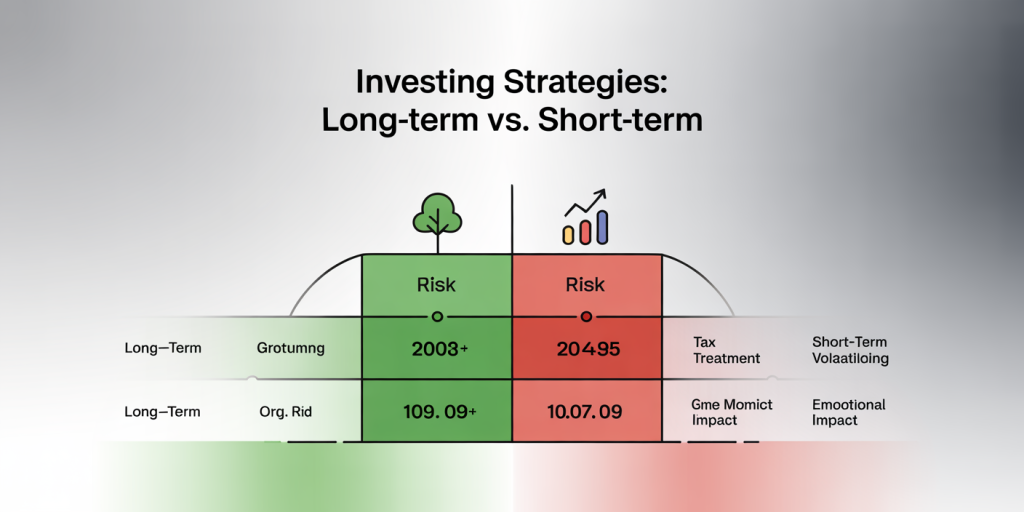Long-Term vs. Short-Term Investing: What’s Right for You?
Investing is a dynamic world where strategies vary widely depending on individual goals, risk tolerance, and time horizons. Two primary investing approaches dominate the landscape: long-term and short-term investing. Each method entails distinct philosophies, risk profiles, and potential rewards. For both novice and experienced investors, understanding the differences and implications of these strategies is crucial for making informed decisions that align with their personal financial objectives.
In this article, we will explore the nuances of long-term and short-term investing, comparing their benefits and drawbacks, and examining which approach might suit different investor profiles. We will use practical examples, relevant data, and provide comparative tables to offer a clear, professional perspective on an essential financial topic.
Understanding Long-Term Investing
Long-term investing is centered around buying and holding assets for extended periods, typically years or even decades. The fundamental premise is to capitalize on the power of compounding returns and the overall upward trend of markets over time. This method often involves investing in stocks, mutual funds, ETFs, or real estate with the expectation that these assets will appreciate steadily.
One of the most well-known examples of successful long-term investing is Warren Buffett, whose strategy focuses on finding undervalued companies with durable competitive advantages and holding them for long spans. Historically, the S&P 500 has delivered an average annual return of approximately 10% over the past century, illustrating the potential of patient investors.
Studies support the long-term approach: a 2023 report by the CFA Institute showed that investors who held a diversified portfolio for more than 10 years were less likely to experience losses compared to those who frequently traded. The approach also minimizes the impact of market volatility, allowing investors to ride out market cycles without emotional decision-making.
Characteristics and Advantages of Short-Term Investing
Short-term investing refers to holding assets for shorter durations, ranging from a few days to a few months. This strategy is often employed by traders who aim to capitalize on market fluctuations, price discrepancies, or news-based events. Examples include day trading, swing trading, and momentum investing.
The primary advantage of short-term investing lies in its potential for quick profits. For instance, savvy traders might buy stocks ahead of quarterly earnings announcements or geopolitical events and sell them when prices spike. The volatility that creates risk for long-term investors can generate opportunities for short-term gains. However, this approach demands active management, timely research, and a strong understanding of technical analysis.
On the downside, short-term investing often incurs higher trading fees and tax implications, especially in countries where short-term capital gains are taxed at higher rates. According to IRS data, short-term capital gains are taxed as ordinary income, which could reach up to 37% for higher-income brackets, compared to the 20% long-term capital gains tax rate in the U.S. This tax disparity can significantly hinder net returns from short-term transactions.
Comparative Table: Long-Term vs. Short-Term Investing
| Aspect | Long-Term Investing | Short-Term Investing |
|---|---|---|
| Investment Horizon | Years to decades | Days to months |
| Risk Level | Lower volatility over time | Higher volatility and risk |
| Potential Returns | Steady growth, compounding effect | Potentially higher but less predictable |
| Tax Treatment | Preferential long-term capital gains | Taxed as ordinary income (higher rate) |
| Time Commitment | Lower; occasional portfolio reviews | High; requires constant monitoring |
| Transaction Costs | Lower frequency of trades | Higher due to frequent buying/selling |
| Emotional Impact | Less stress, focus on patience | High stress, requires emotional control |
| Practical Example | Warren Buffett’s Berkshire Hathaway holdings | Day traders using platforms like Robinhood |

Risk and Reward: Evaluating Your Investment Profile
Choosing between long-term and short-term investing partly depends on individual risk tolerance and reward expectations. Long-term investing generally aligns with conservative to moderate risk profiles, where the investor prioritizes capital preservation and gradual growth. For such investors, the historical data backs the likelihood of positive returns over 10+ year horizons. For example, an investor who started investing $10,000 in the Vanguard Total Stock Market Index Fund in 2010 would have experienced an average annual return of roughly 12% by 2023, translating to over $40,000 in value.

Conversely, short-term investing suits more aggressive profiles willing to tolerate higher volatility and loss in pursuit of potentially superior short bursts of gains. Retail traders during the GameStop (GME) short squeeze in early 2021 exemplify this high-risk, high-reward approach. Some investors saw triple-digit percentage returns within weeks, though many others endured significant losses due to the sudden and unpredictable swings.
Individual circumstances such as financial goals, liquidity needs, and emotional resilience must also be considered. For example, an investor nearing retirement may find long-term investing too risky in terms of market timing, whereas a younger professional with disposable income might allocate a small portion of their portfolio to short-term speculative trades.
Tax Implications and Costs: Financial Efficiency Matters
Taxation and cost efficiency represent critical practical considerations often overlooked by new investors. Long-term investing benefits from tax-efficient account structures and strategies. Retirement accounts like IRAs and 401(k)s in the U.S. allow for deferred taxes on gains, thus maximizing compounding effects. Outside of tax-advantaged accounts, long-term capital gains, taxed at a lower rate, can significantly improve after-tax returns.
On the contrary, frequent short-term trading can erode profits due to higher capital gains taxes and transaction fees. A 2022 study by Morningstar revealed that excessive trading could reduce average annual investor returns by over 1% due to costs alone. These costs compound over time and could nullify otherwise promising gains. High-frequency traders often invest in tools and platforms with minimal fees to mitigate these challenges, but such expenditures can add up.
An illustrative scenario: An investor realizing $5,000 gains after holding an asset for more than a year might owe $1,000 in taxes at a 20% long-term rate. If the gains were short-term, taxed at 37%, the tax liability jumps to $1,850, significantly reducing net profit.
Case Studies: Successes and Failures in Both Approaches
Understanding real-world applications can shed light on the effectiveness of each investment style. Consider Amazon (AMZN), whose shares appreciated over 150,000% since its IPO in 1997. Long-term investors who held onto the stock witnessed extraordinary wealth creation. Short-term traders, however, would have needed keen timing and market knowledge to avoid volatility stalls.
On the flip side, consider the rapid decline of cryptocurrency Dogecoin (DOGE) after a speculative surge in early 2021. Short-term traders who exited at the peaks reaped considerable rewards, but many who held longer faced steep losses as the market corrected. This showcases that while short-term investing can capture transient opportunities, it also demands a strong exit strategy.
An additional example is the Dot-com bubble burst in 2000. Long-term investors exposed to individual tech stocks without diversification experienced major losses, whereas disciplined short-term traders capitalizing on volatility and employing stop-loss orders mitigated financial damage.
Future Perspectives on Investing Strategies
The investment landscape is rapidly evolving with technology and macroeconomic factors shaping future trends. Robo-advisors and automated trading algorithms increasingly influence both long-term and short-term investment management. These technologies allow greater customization of portfolios, balancing risk and return according to personal preferences.

Moreover, the rise of sustainable investing and Environmental, Social, and Governance (ESG) criteria favors long-term investment, as companies with sound governance and environmental practices tend to generate sustainable returns over time. According to Morningstar’s 2024 report, ESG funds outperformed their non-ESG counterparts by 2.4% annually over the past five years.
Meanwhile, short-term investors are gaining new tools such as AI-driven predictive analytics and enhanced market data, facilitating more informed and faster trades. However, increased market efficiency could reduce short-term arbitrage opportunities, shifting the risk-reward balance.
Investors must stay informed about regulatory changes and economic shifts—such as rising interest rates or inflation—that could impact the viability of either strategy. Diversification, combining elements of both long-term and short-term investing in a blended approach, might emerge as a pragmatic solution to future uncertainties.
Choosing between long-term and short-term investing depends on a nuanced blend of personal circumstances, market knowledge, and financial goals. Both strategies hold unique advantages and challenges. By understanding these dynamics, investors can tailor their approach to maximize growth and resilience in tomorrow’s markets.
